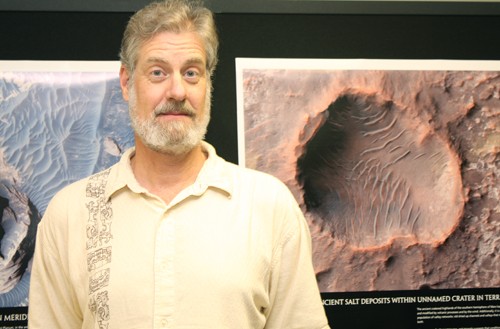Scientists have discovered craters in Mars filled with almost-pure ice with the help of UA technology and say they are hopeful that this discovery will lead to possible missions there for astronauts.
The High Resolution Imaging Science Experiment, or HiRISE, is comprised of a team of UA scientists who operate the high-resolution camera that captured the images of ice on Mars’ surface from NASA’s Mars Reconnaissance Orbiter.
“”UA’s role was really key,”” said Shane Byrne, member of the HiRISE team and assistant professor of planetary sciences at the Lunar and Planetary Sciences Laboratory, the lab HiRISE calls home.
Research on Mars’ ice has been led by researchers at the Lunar and Planetary Lab like Dr. William Boynton, who operated a gamma-ray instrument that detected all the buried ice on Mars for the first time several years ago, and Peter Smith, who recently led the Phoenix mission which dug up and analyzed ground ice on Mars.
“”I’d say that UA hasn’t just contributed to Mars research, we’re leading it,”” Byrne said.
Scientists had been studying ice on Mars for a few years before they chanced on the crater findings, researchers said. Because ice usually disappears quickly on Mars’ surface, the sites must be photographed quickly.
The team did not expect to find ice so far away from the poles, Byrne said.
Since Mars’ orbit around the sun constantly changes, its climate changes as well. Earth goes through similar changes but on a much smaller scale since Earth’s moon helps stabilize the planet from big changes, Byrne said.
As on Earth, when the temperature on Mars drops, ice at the poles spreads down toward middle latitudes, and when the temperature rises it retracts towards the poles, Byrne said.
“”The ice that we’re seeing in these craters was put there during one of these climate changes about 10,000 years ago. These craters are actually at about the same comparative latitude as Seattle, so it was a surprise to find that the ice was still there,”” he said. “”It would be like someone in Seattle digging a knee-deep hole in their back garden and finding a slab of pure ice left over from the last ice-age at the bottom.””
Since tests have already confirmed that the ice is 99 percent pure — nearly free of dirt and impurities — scientists will be watching for future impacts to get a better understanding of the distribution and purity of ice on Mars, said Alfred S. McEwen, Planetary Image Research Lab director and principle investigator. He added that the ice could prove to have valuable practical uses.
“”For the future, the ice may be a resource available to people living on Mars, to drink and to break down into oxygen to breathe,”” he said. “”And for rocket fuel to visit home.””









